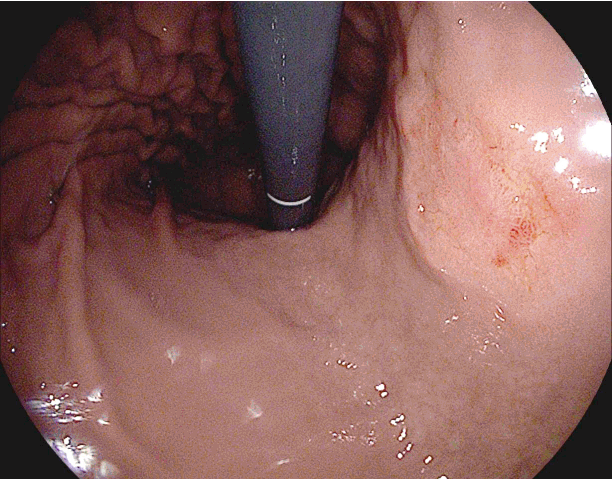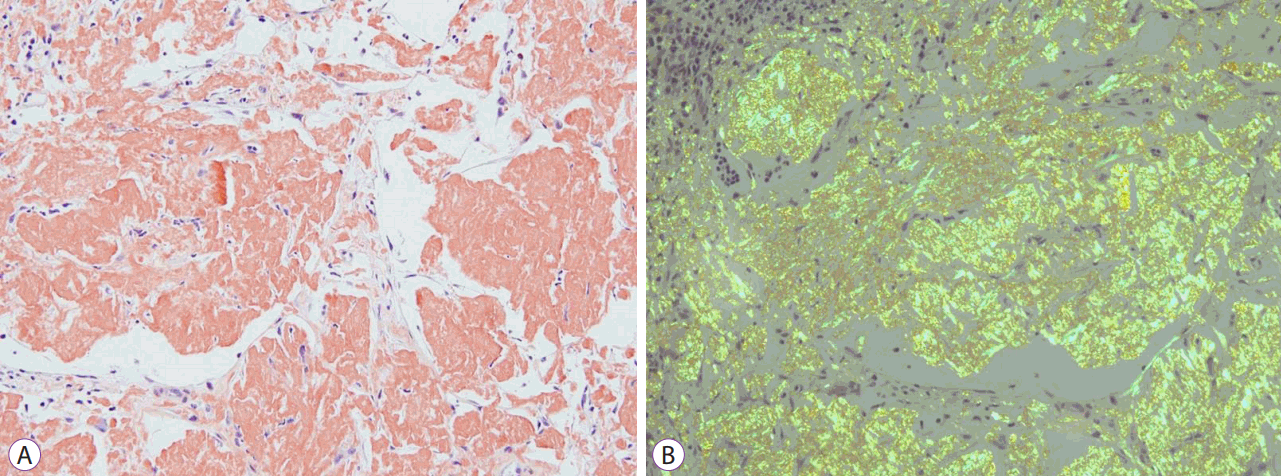A 55-year-old woman visited our clinic as part of the national health screening program, which included EGD for cancer screening. She had been diagnosed with breast cancer 2 years prior at our clinic, had undergone a simple excision of the left breast mass, and had been taking an oral nonsteroidal aromatase inhibitor (letrozole). She had no clinical complaints, and general physical findings were unremarkable. Laboratory tests in the national health screening program, which include measurements of hemoglobin, aminotransferase, fasting glucose, and creatinine and determination of the cholesterol profile, revealed no abnormal findings. EGD revealed the presence of a round lesion measuring approximately 20 mm in diameter with a central depression in the lesser curvature of the mid-gastric body. The lesion had irregular edges and slightly heaped-up margins, with focal distorted vessels and an uneven pale-colored base (
Fig. 1). On EGD, the lesion resembled early gastric cancer; therefore, several biopsy specimens were collected. However, histopathologic examination revealed dense lymphoplasmacytic infiltration and amorphous eosinophilic material deposition in the lamina propria, without malignant findings or lymphoepithelial lesions. Congo red staining identified amyloid proteins (
Fig. 2A). Apple-green birefringence was shown using polarized light microscopy (
Fig. 2B). Immunohistochemical staining to classify amyloid protein subtypes revealed that all plasma cells within the mucosal layer were κ and λ chain-positive (
Fig. 3). Random tissue biopsies, which were performed in the duodenum and colon to evaluate the presence of amyloid proteins in other GI regions, were negative. Echocardiography did not show any abnormalities other than abnormal relaxation and diastolic dysfunction in the left ventricle. Computed tomography of the chest, abdomen, and pelvis did not show any significant findings. Additional laboratory findings for serum immunoglobulin (Ig) levels (IgG, 1,297 mg/dL [normal range, 700–1,600 mg/dL]; IgA, 182 mg/dL [normal range, 40–230 mg/dL]; IgM, 147 mg/dL [normal range, 70–400 mg/dL]; β
2-microglobulin, 1.37 mg/dL [normal range, 0.76–2.13 mg/dL]; free κ chain, 12.31 mg/dL [normal range, 3.30–19.4 mg/dL]; and free λ chain, 13.79 mg/dL [normal range, 5.71–26.3 mg/dL]) and serum complement levels (C3, 120 mg/dL [normal range, 90–180 mg/dL] and C4, 38 mg/dL [normal range, 10–40 mg/dL]) were normal, whereas those for serum antinuclear, rheumatoid factor, and antineutrophilic cytoplasmic antibodies as well as urinary Bence Jones protein were negative. Immunoelectrophoresis results of serum and urine were nonspecific. A bone marrow biopsy was not performed due to normal serum and urine Ig levels and negative immunoelectrophoresis results. Based on these data, the patient was diagnosed with localized gastric amyloidosis with co-expression of Ig κ and λ light chains. Because she had no symptoms, the patient did not receive any further treatment. In the first year since the initial diagnosis, the patient remained in good condition, no significant changes in the lesion were observed in the biannual endoscopy, and there were no abnormal laboratory findings.
 | Fig. 1.Endoscopic findings. A round lesion approximately 20 mm in diameter, with central depression and a pale-colored base on the lesser curvature of the mid-gastric body. 
|
 | Fig. 2.Histopathologic findings. (A) Congo red staining shows amorphous amyloid proteins (Congo red, ×200). (B) Apple-green birefringence is shown using polarized light microscopy after Congo red staining (Congo red, ×200). 
|
 | Fig. 3.Immunohistochemical staining shows the presence of plasma cells with co-expression of kappa (A) and lambda (B) light chains in the mucosal layer. 
|





 PDF
PDF Citation
Citation Print
Print





 XML Download
XML Download